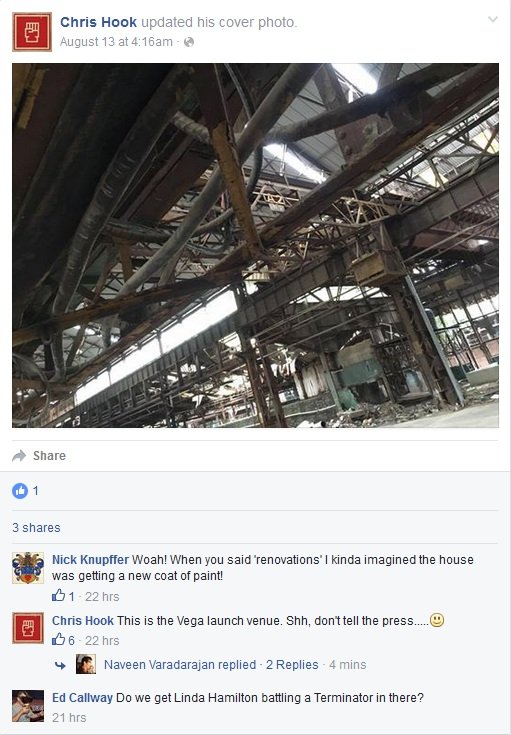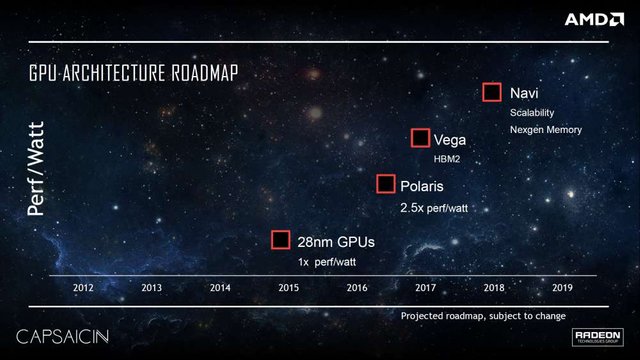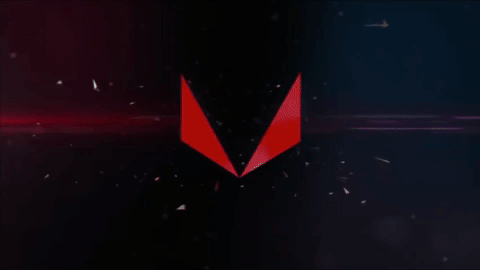So what is going with Radeon Technologies Group after Vega's release?
As fancy as that Gif looks, the feelings toward Vega's release is quite the opposite. Reviewers citing a lot of issues to do with the card's thermals causing it to throttle in some games, abysmal power draw and the performance in majority of games that are polarizing, either runs better with an AMD optimized title or runs little lackluster in Nvidia GameWorks titles. The main competition was the latter's GTX 1080....well the founders edition card basically. Whatever the case in point may be from professional enthusiasts, consumers aren't too thrilled about the late-in-the game delivery of the Vega Cards; both Vega 64 and 56, with 56 coming to stores at end of August. BUT, the startling realization came after day-one sales that AMD was selling the 64 at lower price thanks to rebates, by which afterwards all of the card's price increased by 100 USD opposed to the official MSRP listing. Now all GPU's prices are high cause of the mining purchase spree ongoing everywhere. You'll find every GTX cards priced over 60-150 USD, but that justification was no longer the front of the issue. Reviewer's and consumers became tense, distraught with AMD's approach to the pricing scheme bringing massive outcry including YouTubers who voiced their opinions; citing it as "bait and switch" tactic. That is still the current situation we're in, it's been over a week and there's still people talking. So let's dwell into the big question. WHY DID RAJA (somewhat) MISLEAD US THIS WHOLE TIME?

Total Recall:
Vega was first announced back in 2016, after Polaris 10 release back in May. AMD has already expressed themselves believing that Vega would be next big architecture against Nvidia's high-end cards. The first tease from the above came after Raja Koduri announced from Radeon Technologies Group that Vega was coming, that it was going to change the name of the game, everything about 3D applications including gaming, but mind that part I said "3D application" cause we're gonna get into details about that much later here.

This was the roadmap chart shown in Capsaicin Siggraph 2016 and pretty much stayed true till AMD decided to push Polaris cards further to churn out every bit of clock speed and that meant drawing out more power for their 14nm silicon chips. Now that's the problem with silicon, when you try to push a barrier for more performance (overclocking) the perf/watt index changes, exponentially increases. Thus you have a card running at 1400Mhz but drawing 180W of power from AIB cards, compared to 1060's 130W, which lead me to believe AMD was panicking and in knee jerk reacting did this. This was a year ago, they've re-released Polaris 10 with 500 series cards, with only improvement to show for was overclocking headroom thanks to change in 3rd gen FinFet design called (LPP). Which was the final design they needed for Vega to push the clockspeeds much higher.
Wiggle room:
Both Nvidia and AMD had time to optimize their drivers further within the timeline of 2016-17, Nvidia opposed by AMD's performance updates released newer drivers for their Pascal cards, only to more affect in few games while the rest were minuscule. AMD on the other hand, they've tried everything after the release of the 500 series cards; With Update Radeon Crimson ReLive 17.7.2, they've increased performance by reducing rendering latency via CPU drawcalls, gave features like Enhanced sync and improved Linux drivers. This was after the huge success of AMD's Ryzen CPUs. So in performance margin, AMD seemed ready to take on Nvidia, now that 580 seems to be as 85% better than 1060 on majority of the games overall. But not Vega, since it was released, a day later AMD released a driver addressing Overclocking bugs and performance issues even though that didn't made the card looked like it was well prepped and ready for use, there are still optimization issues ongoing, pretty normal considering this is how AMD works with GPUs after release, the drivers get better after time. Here's a benchmark video from Hardware Unboxed to explain how Vega is performing right now.
Is it a true successor?:
Tech aficionado's like me are curious to know whether it did improve itself compared to AMD's previous flagship, R9 Fury X in relative clockspeed performance. Well here's the site that explains it well (P.S: It's German, you could use Google Translate from Chrome or have a translator web-extension for other browsers). I also recommend in the near future you follow up from them in case any major product releases from AMD Radeon Group happens.
Diverse markets:
Well I hate to break it to you guys, but this is the part where I start talking about "3D applications" and compute power of the card. Vega is immensely power when it comes to professional tasks, that amount of teraflops is situated for video rendering, computing and mining. Yeah it can do 34-36MH/s hashrate, that is a lot even trumping over GTX 1080 Ti's 31MH/s at Ethereum. Now for 3D applications, Vega 64 was created as a workstation card in and out, I think Techgage did a good review mainly emphasizing tests for professional applications at this link. Even after the teasers and it's CES 2017 showcasing back in January along with Ryzen, AMD was still endorsing their product for gamers including added features like Freesync 2.0 which is affordable more than Gsync from Nvidia within monitors, better Vulkan support from games etc. But within the last couple of months later on, their attention towards us was dwindling, Capsaicin & Cream event afterwards was mostly about how the Vega architecture was an asset for developers, programmers and in film industry. Speaking of which, did you know AMD is aggressively marketing towards Hollywood?
In conclusion:
For red team fans, no Vega is not the salvation we've been waiting for. It seems AMD has realized that after Nvidia's architecture of Maxwell, they haven't been able to step up in their game since Fury X's launce in 2015, matters made worse was when Pascal came out and it was dubbed to be Maxwell on steroids cause of the insane overclocking headroom it had. Pushing towards 2Ghz in core clockspeed. I think what did is all in fault cause of GlobalFoundries fabrications needing a lot of power draw for it's silicons, efficiency is lacking but also blame should go towards AMD still using their outdated GCN architecture. By late 2011, it was heralded as a highly lauded being steps ahead, even beating Nvidia Kepler. But boy did the empire strike back hard in 2014 after Maxwell's release and in return put AMD at a stranglehold. Only Navi could finally help AMD pave the way to victory, but will require a big investment for R&D and a big change within their architecture. I just hope for now, AMD makes a good money if not from gamers but other consumers or prosumers to finally get the resources to prepare, after all they've made a lot of money within the year and half thanks to Polaris sales and the best-selling Ryzen series CPUs.
This is your Tech-nerd, Trave160 signing off.

Thank you guys, I added additional details regarding clockspeed performance compared to Fury X from 2015.
still believe we are being robbed by these companies who are now asking us excessive prices for graphics cards due to crypto mining.
@rogerblu